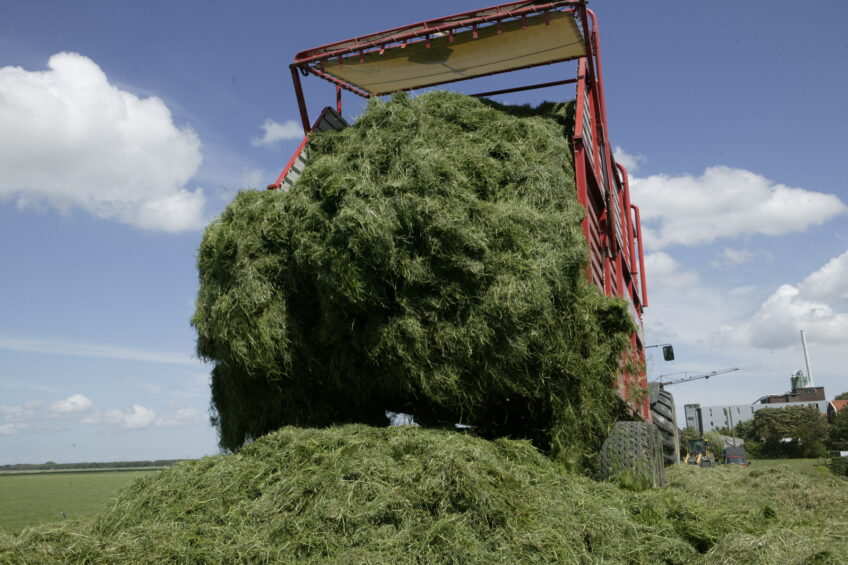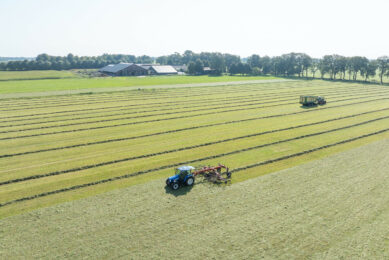Make the most of this year’s harvest

During the past few months, milk and meat prices have been challenging. At the same time, climatic conditions show great variability and insecurity, resulting in highly variable forage quality. Optimal forage preservation is therefore key.
Silage, when properly preserved, is an efficient way to ensure a year-long supply of nutritive forage. The quality of silage will depend on the time it takes for the fermentative phase, or front-end fermentation, to complete (Figure 1) as well as the stability of forage during the aerobic phase (back-end fermentation).
This is determined by a number of parameters linked to the plant itself (sugars, dry matter (DM), protein content, etc.), the silage making technique (ensiling rate, packing, chopping length, etc.), the silo (sealing, etc.) and the presence of inoculants. When compared to other types of forages, such as maize, grass has some specific characteristics that can impact silage preservation at different levels:
Grass has low sugar content, which can slow down the front-end fermentation, grass can have high protein content, which can increase the buffering capacity of the forage, slowing down the fermentation and making it difficult for the pH to drop and grass can have a high DM content. When DM is more than 30%, aerobic stability can be jeopardised, translating into further DM and nutrient losses.

Optimising front-end fermentation
Front-end fermentation is key to ensuring efficient preservation. An ideal fermentation drives a quick drop of pH, inhibiting the spoilage micro-organisms, preserving protein and avoiding front-end DM losses. When front-end fermentation is slow, and if conditions are favourable for their growth, clostridia might develop and, as a consequence, pH drop is slower — driving further undesirable fermentations and losses of nutrients and DM. One of the main drawbacks is the degradation of proteins, or proteolysis, both by endogenous enzymes from the plant or by micro-organisms.
As a result, the forage loses its nutritive value and ammonia nitrogen is produced, which, when consumed in excess, is detrimental to animal health. Front-end fermentation depends mainly on the level of lactic acid bacteria within the silo (endogenous from the field or brought by an inoculant), and the level of ‘food’ available for these bacteria. This ‘food’ can be simple sugars, or water soluble carbohydrates (WSC) that are converted into lactic acid. The addition of an inoculant containing homofermentative lactic acid bacteria can help speed up the process. In addition, in the case of low sugar content forage, enzymes can be added to help degrade plant fibres into WSC, providing more food for the lactic acid bacteria. Several trials have shown that the use of adapted inoculant is effective to help control DM and protein losses in grass. What’s more, inoculants can be financially efficient. For example, a trial performed in the UK in 2002 (Lune Bank School Lane Pilling), indicates that the use of acidifying inoculant* improves front-end fermentation by decreasing pH faster and increasing lactic acid concentration as compared to untreated silage (Figure 2).

Aerobic stability
Following storage, a normally stable phase, feedout can represent the second bottleneck of forage preservation, due to back-end fermentation in the presence of oxygen. This is defined as aerobic stability. Exposure to air is the first domino to fall that causes a chain reaction, ultimately resulting in spoiled feed. Grass with high DM (more than 30%) content is more sensitive to aerobic instability. In this case, extra care should be taken to ensure optimal packing and sealing of the silo. In addition, the use of an inoculant containing proven anti-fungic heterofermentative bacteria such as Lactobacillus buchneri 40788 is recommended to help improve aerobic stability, resulting in reduced back-end DM losses. For example, a trial at University of Florida showed a 10.2% higher DM recovery, when using an inoculant containing L. buchneri 40788, LALSIL Dry compared with control silage (Figure 3).
In addition, protein degradation is prevented, as shown by the lower ammonia concentration in treated** silage. The absence of butyric acid in the treated silo further confirms that spoilage by undesirable microorganisms is prevented. When looking at financial return-on-investment, taking into account solely the level of DM recovery and with a silage estimated at €100 per tonne of DM, using the treatment in this case allows saving an equivalent of €10 per treated tonnes. Plus, there is the added benefit of preserved protein content and absence of butyric bacteria development.

Preserving forage digestibility
In situations where WSC content is limiting initial fermentation, enzymes can help transform some structural carbohydrates into soluble sugars, like glucose. Research and trials have shown, that, in addition to their primary role of improving fermentation, the use of enzymes in silage inoculants can help animals gain energy from the feed by improving fibre digestibility. A trial conducted at ADAS Drayton in the UK, showed an increase of 19% NDF digestibility after eight hours rumen incubation time when using enzymes, compared to the control. This increase in NDFd at eight hours rumen incubation time is quite important in high milk producing cows, which have a similar average ruminal passage rate. It can be linked to an estimated increase in milk production of 0.8 kg. Another trial, conducted at Centro de Investigaciones Agrarias de Mabegondo, Spain, showed the inoculation of grass silage with an enzyme-containing inoculant*** increased DM digestibility by 3.7% when compared with control silage. This increase in DM digestibility promoted a higher milk production, in this case an extra 3.5 kg milk.
Conclusion
In conclusion, grass DM and nutritive quality can be optimised at three levels thanks to the use of adapted silage inoculants: Better DM recovery through optimal front end fermentation, better DM and protein preservation through aerobic stability and improved fibre digestibility for higher milk-from-feed ratio.
* LALSIL CL, ** LALSIL Dry, ***LALSIL PS
Join 13,000+ subscribers
Subscribe to our newsletter to stay updated about all the need-to-know content in the dairy sector, two times a week.










